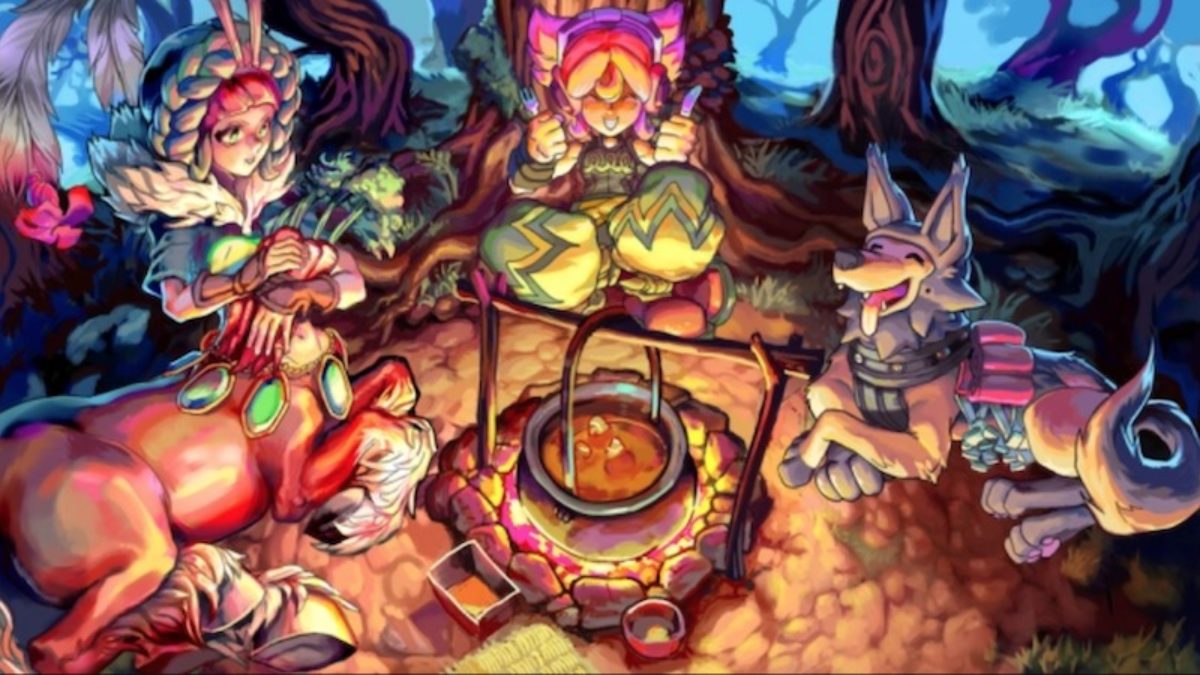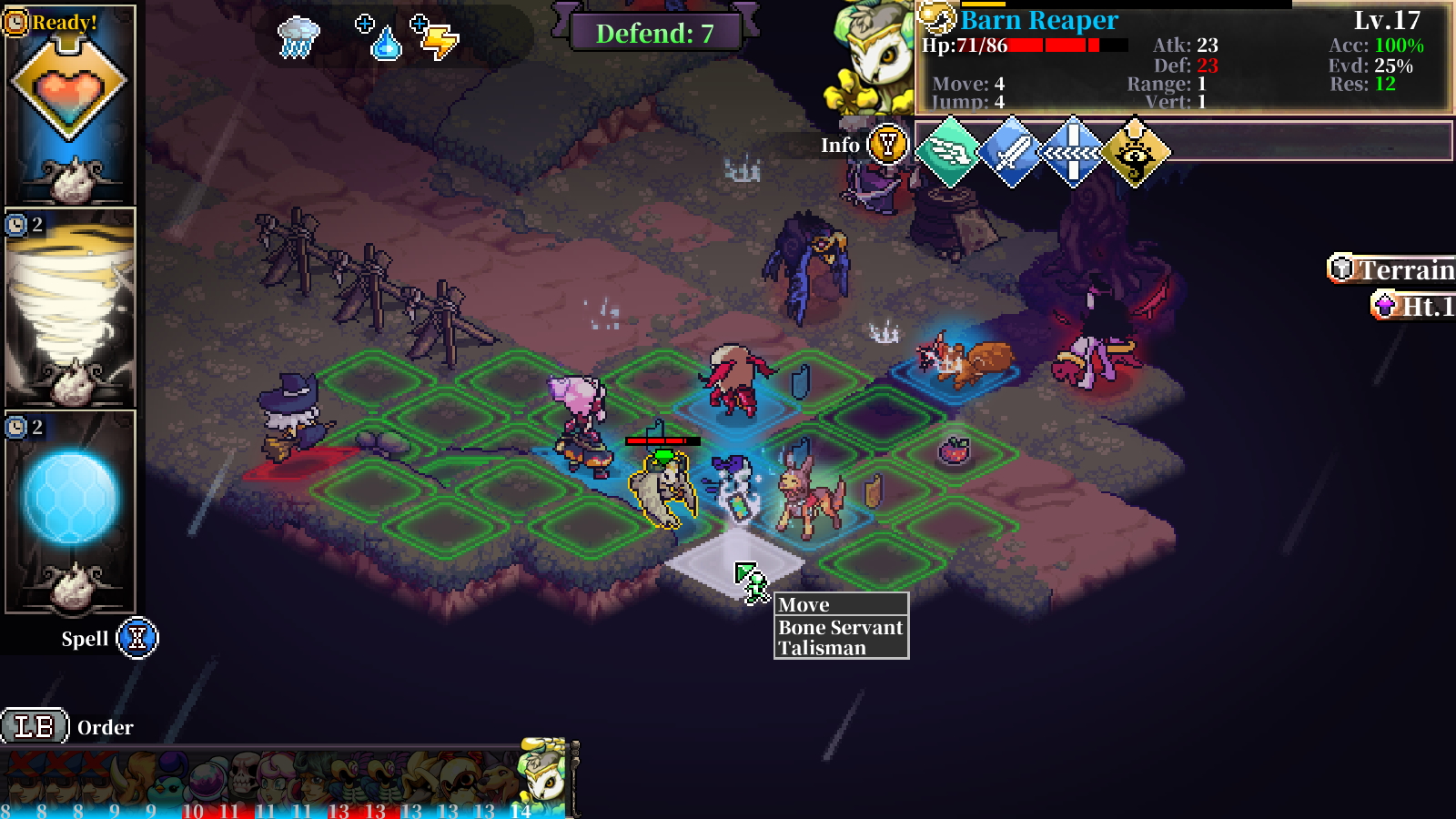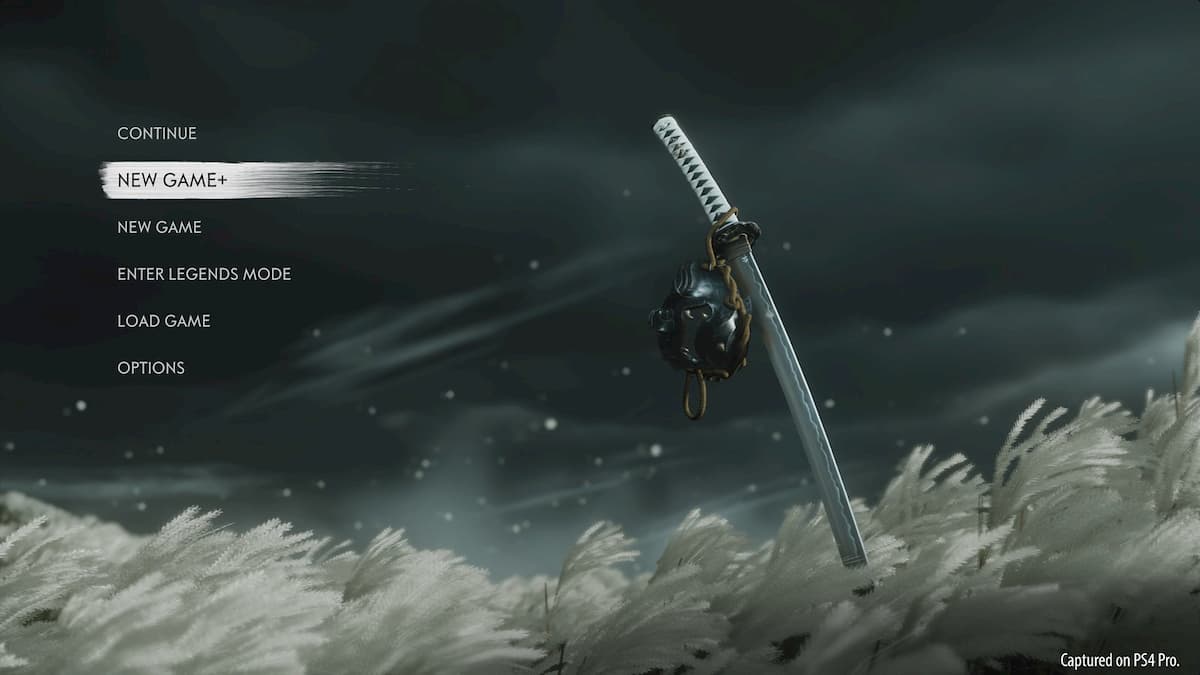
What is it? A charming, turn-based strategy RPG.
Developer: Endlessfluff Games
Publisher: Humble Games
Price: $20
Reviewed on: Windows 10, Intel Core i5-9600K, 32GB of DDR4 3200MHz, AMD Radeon R9 380, Samsung SSD 850 EVO 1TB, Steam Controller
Multiplayer? No
Link: Humble Bundle
Fae Tactics lays out building blocks that most turn-based strategy players are already familiar with: elemental rock-paper-scissors, creature collecting, and combo attacks. From there, it subtracts a lot of menus, creating a stripped down and faster experience than classics like Final Fantasy Tactics. But what took longer to set in was what I came to see as the core aspect of the game—the idea that I wasn’t assembling a team like XCOM, but a toolbox. Nabbing new summons in Fae Tactics wasn’t up there with naming my alien-fighting marines after friends, but my weird menagerie had their own charms.
As Peony, you start out fixing your broken down motorcycle and then get drawn into witches, kingdoms, and an ancient war between humans and fae. Amid this conflict, Peony’s searching for her mother. But I actually found that the strange smaller stories—like a boxing chicken trying to beat a corrupt mafioso—were the most entertaining to me. Fae’s DNA is entwined with other JRPG and anime-inspired games, but it scribbles a silly face on its post-apocalypse faerie world and doesn’t drown in long dialogues.

As a strategy game, Fae Tactics lets you get comfortable in a routine for a few battles, then upsets that routine. Elemental enemies approach in a squad out for blood, environments supercharge one particular type of enemy, and traps and features of the battlefield range from amusing to deadly. Some of these challenges are painful the first time you encounter them, resulting in difficult battles if I didn’t adapt my party composition or tactics. In one case I watched bemused as the battlefield turned into a pinball table, flipper traps throwing my poor unit around and dumping him, poisoned, in front of the boss and halfway across the map from me.
Other times, I found ways to turn enemies’ traps against them. One time a gremlin was operating a cannon covering the bridge over a pond, with another enemy blocking the far side. After my two attempts were spent getting blasted by cannon fire, knocked into the water, and thoroughly embarrassed by the gremlin squad, I started my strategy over. This time I swapped my summoned units out for a pair of flying ones, who merrily flew across the water to clear out the living roadblock so I could safely run across. The gremlin manning the cannon continued to fire at the same empty bridge for the rest of the battle. You do you, little guy.

The most frustrating thing I encountered in Fae Tactics is a familiar gaming trope: protection missions. These friendly NPCs often had a different idea of the battle plan than I did, and would run away out of my healing range just to perform some weak elemental attack. About half of my lost battles were due to these friendlies getting absolutely nuked by a lucky ultra crit or simply running directly into danger. These setbacks weren’t so frustrating that they stopped me from wanting to swing at the next summon-piñata, though, and my drive to continue to add new options to my stable was high.
Fae’s DNA is entwined with other JRPG and anime-inspired games.
Sometimes I missed the lack of more in-depth customization or abilities for my characters, a genre staple in games like Disgaea. Summon units (creatures, basically) and leader units have simple standardized abilities on attack, assist, and wait, and there are no classes to advance in. Summons use preset abilities, and leaders can only advance on three passive paths—essentially offense, defense, and other. With the only customization being my choice of unlocked weapons and one other equipment slot, I often wished I could take my favorite leader and tweak them with more options, but Fae Tactics is deliberately streamlined, nixing nested menus in favor of the feeling that you’re bringing a small toolbox into each encounter. Fae Tactics wants you to find good strategies, but it doesn’t want you complacent in them.
This less-is-more approach fits well with the flow of combat. With most abilities being passive effects (regenerating HP per round, walking on water, etc), I quickly learned the grammar of the grid. This left me free to make active decisions—should my unit attack to trigger a combo, assist to set up my next move, or wait? I’ve recommended many tactical RPGs to friends over the years, and have heard before that the layers of menus were too much for them. If you’ve had this issue, Fae Tactics has been designed to sidestep it entirely. Battles themselves still take between 20 and 40 minutes, but you won’t spend so much of it selecting and confirming things.

My most rewarding moments were battles where I brought just the right composition of units—you pick three powerful leaders, three simpler summons, and three spells to bring into combat immediately before each fight. After surveying the battlefield and selecting, I could position my melee units to set off combos that would land multiple back attacks and crits in a rapid-fire blitz of damage. I like how this feels, like I’m in command of my ultimate strategy, but it wasn’t effortless—I’d often have to respond to unexpected reinforcements. In one case, I was down to just my battered trio of leader units after surviving the initial wave, and the enemy was regenerating so quickly that the battle was slipping away. Careful maneuvering and luck earned me a great set of crits and an Ultra against them, but failed to seal the final 13 damage. The boss, a fairy creature, wound up another poison blast against me, and not only did my dog pal Chico use his defender ability to block the damage, but counter-attacked to finish the job. See you later, tinkerbell.
As for the characters themselves, Peony the totally-not-a-witch and her growing band of misfits are pretty endearing. Her starting companion Chico, a lovable dog with a dopey look on his face, quickly became my favorite for how good he was at protecting the rest of my squad. Peony’s search to discover what happened to her mother isn’t all that gripping, but it’s a good excuse to explore Fae’s anime-sketchbook world. I gravitated toward the story quests, finding that they were more interesting and had better designed battles full of new circumstances and hazards. Plus, even the side quests I embarked on also had small arcs that would often reward me with a new leader, or some new equipment. The difficulty curved fairly evenly following the main story and doing most of the side quests, and I rarely found myself needing to even look at the random battles for grinding XP. Not being able to save during strings of battles was a serious problem at several points, forcing me to repeat several battles if I didn’t want to leave the game running for long periods.
While the story occupied a lot less of the game than the combat, I found it impossible not to love some of the weird menagerie of animals I was collecting. There’s a nostalgia about the quirky creatures and vibrant colors that makes even the weirdest of the creatures appealing. Part of me wants to slide their character portraits into a card binder like I did with my favorite Pokémon when I was little. Except Chico. He’s going in the display case with my holographic Charizard.
Read our review policy
Fae Tactics takes an enjoyable swing at streamlining a complex genre, but doesn’t reinvent it in the process.







More Stories
Doom Eternal review
Review: The Last of Us Part II complicates the idea of right and wrong
Dirt 5 review